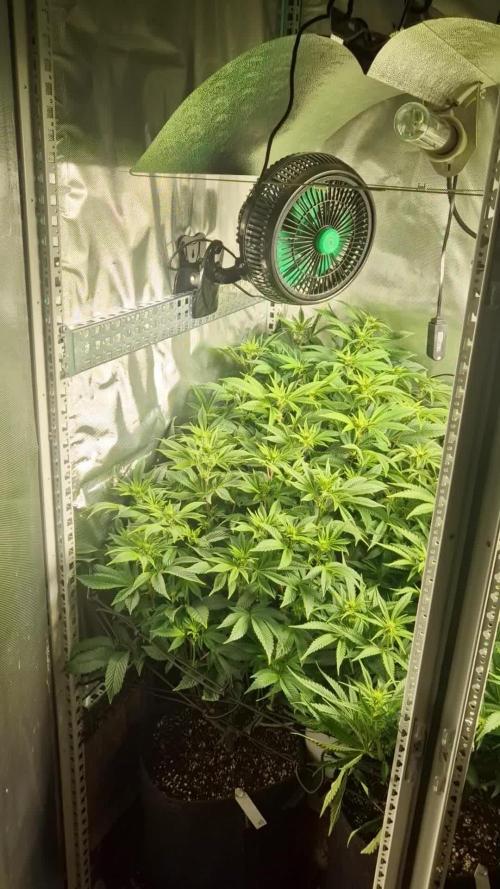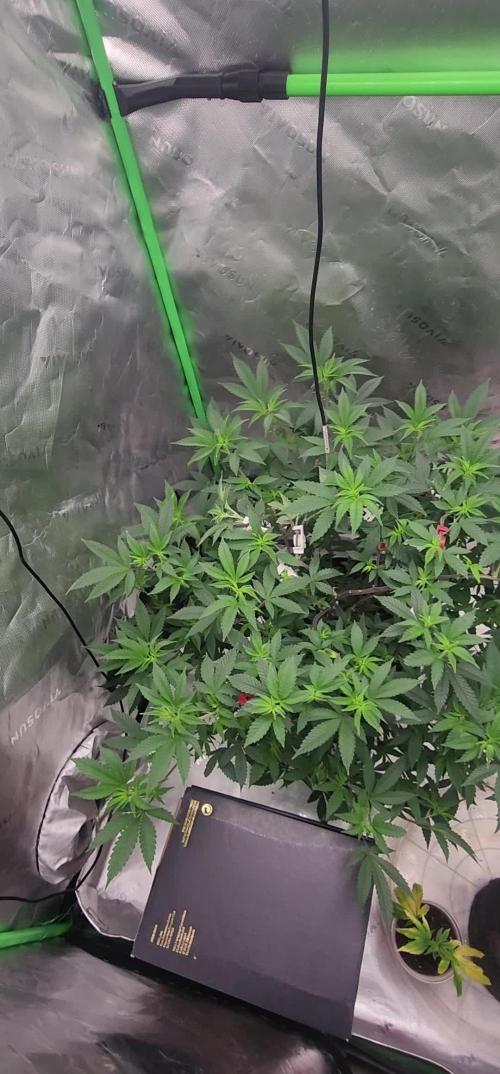The Grow Awards 2026 🏆 



































Likes
Comments
Share


@Papaganja
Follow
Wie immer in meinem Garten alles tiptop keine Beschwerden von mir!!!!! DANKR FÜRS BETRACHTEN MEINER ARBEIT 😍😘
Likes
47
Share


@AsNoriu
Follow
Day 9. All is running very nice. Happy with light performace a lot.
Girls missed wind a bit, but i cant make it faster, because of neighbours and sound, so i took humidity dome away.
TSL2000 runs 40 cm away and on 40% output.
Girls get daily shower , try to keep some wet cloth to maintain humidity.
Happy Growing !!!
Likes
20
Share


@Mtmtc
Follow
Over the next 7 days, I will be flushing this plant to prepare it for its final harvest. Stay tuned for the upcoming results!
Likes
37
Share


@iMpulsive_Grow
Follow
Day 65!
They are doing so well but they are super thirsty! Also the odor is a lot stronger now 💚💚
Day 66!
32”!
Day 67!
Not much to say
Day 68!
The trichomes are growing quickly and smells great 😊🌱💚
Day 69!
From being so obsessed with the plants I got carried away with the shots lol
Day 70!
Just fed them 2 days ago and gonna have to feed tomorrow. They are thirsty!!
Likes
7
Share


@Messypies
Follow
The plant started off good. Unfortunately the environment wasn't the best to begin with but overall I think with the deficiencies still present. It turned out okay.
This was grown with just the standard grow micro bloom. Due to covid, I was unable to order additional macro nutrients. Yeilds suffered as a result but overall happy for my first grow.
Likes
7
Share


@Mimi420
Follow
Day 14 Flower — girls looking sweet, stretch winding down 🌿
Day 14 of flower and the girls are loving it — canopy’s filling out and I think the big stretch is starting to settle. I topped up the pots with a bit more soil and did a light clean under the canopy — one more proper lollipop/clean and then I’m leaving them to do their thing. Did a few gentle supercrops where needed to tame the highest tops.
Big worry right now — night humidity. My box lives in a cold, damp garage so I have to switch the inline exhaust off at night or temps drop too low. I’m running a 150W cabinet heater to hold nights around 17–20 °C, and two circulation fans (one under the net, one above) run 24/7, plus a small dehumidifier that’s not keeping up. With the exhaust off RH jumps to ~80–85% overnight which is a real risk for bud rot as the colas fatten.
Feeding & training: pots got a top-up of soil, still on the same organic program. I cleaned the lower growth today and tucked what I could — after one last clean I’ll stop heavy training and let them bulk.
If anyone’s run into the same cold-garage / high-night-RH issue — what worked for you? I’m thinking:
better dehu (bigger mini unit) or routing a drain from my small unit outside the box,
short timed bursts on the inline fan overnight to avoid full-on chilling,
or a tiny heater + targeted air mixing to keep box temp up without frying the plants.
Appreciate any real-world tips. Pics attached in my diary. #GrowDiaries #SCROG #Day14Flower #IndoorGrow #HelpNeeded
Processing
Likes
1
Share


@Esebees
Follow
Cambiamos de fotoperiodo y las plantas rápido han pegado el cambio y ya sacan los primeros pelitos
Likes
12
Share


@AtomicOrgy
Follow
It's getting bigger and frostier. The mold on the rockwool is gone and she didn't have mildew after all. The smell is gorgeous, I have never seen anything like it.
Likes
3
Share


@123Grow
Follow
This is for the RQS autumn cup.
I also use SST’s: Corn and Lentils
LABS ( lactic acid bacteria serum)
Looks like I have 137 days to harvest these 4. So that means 2 full months of veg and 65 day of flower.
Happy growing to everyone
Likes
16
Share


@CookiesAndCake
Follow
Week 14
Day 92 (13/11/2020)💧:
Great start to the week with watering today and because all the girls are entering their 4th week of flower, I will again be increasing the BioBloom as per the commendations on the watering chart, but since the pH has been increased they are definitely looking great and have enough nutrients between the watering days. So today I gave the girls 4.5 ml of BioBloom, 1.5ml of BioGrow, 1.5ml of CalMag, and 1.5ml of TopMax for 1.5L of water. I think I will be giving the same nutrients for the rest of the week as well.
Day 93 (14/11/2020):
Not that many updates today actually. The girl is looking amazing as always
Day 94 (15/11/2020):
I wanted to check the trichomes on the girl today with a loupe to see how she is developing up closer but I have no idea where my loupe is :( Really wanted to look closer at the flowers but will have to find it first to take some close up pictures as well
Day 95 (16/11/2020)💧:
We watered the girl today and gave her the same nutrients as before. They were watered with 4.5ml of BioBloom, 1.5ml of BioGrow, 1.5ml of CalMag and 1.5ml of TopMax. I think the TopMax is definitely making the buds fatten up.
Day 96 (17/11/2020):
The girl is super healthy and looking great, I took a picture from below because it’s quite hard to show how she is growing now. She is definitely the smallest girl and has the smallest buds even now after giving TopMax but from the bottom is looks like quite a lot of flowers.
Day 97 (18/11/2020):
Not that many updates today, just gonna mention that the girl does not smell as strong as the others in the tent. The others smell so strong that it is getting through the closed tent. DSD smells quite nice but the smell is not strong at all. It is very earthy, maybe a bit of pine, so quite a nice smell just not enough of it! I wonder how it will be after the flowers dry...
Day 98 (19/11/2020)💧:
I keep wanting to measure the pH to make sure that it is still above 6.0 but I haven’t had enough time because it takes a while, but I will make sure to measure the pH before the next watering. So still watering with the same nutrients as at the beginning of the week with BioBloom, 1.5ml of BioGrow, 1.5ml of CalMag and 1.5ml of TopMax. Although I think this will be the last time I will be adding CalMag because the girl looks like she does not have that deficiency any more. Also it looks like she stopped stretching length-wise and started focusing on growing the buds because the height is the same as last week. But really amazing progress this week, I’ve included a video of all the girls in the tent as well so it’s easier to see how different they are!
Likes
30
Share


@WeWantItToGrow
Follow
Did a little outside action this week as I had to clean out the tent and make some ventilation adjustments I’m 9 weeks in on these plants and it kinda has me wondering why I’m not seeing much more vertical growth I’ve decided to pull the light up a bit and decrease the intensity let ‘‘em work for it a little bit.They are healthy tho and as usual the vegetation never fails to impress happy growing yall
Likes
20
Share


@PureMedicin
Follow
Im very happy with the progress so far. One of my better vegetative periods thats for sure. I removed my scrog as it was annoying to work with
I did only water 1 time this week. Gave them around 1,2 liters each. Some a little less. PH 6, nutrients solution strenght is at 100% and they seem to be loving it. No signs of defficiencies to my knowledge.
My grow tent is a little hot peaking at 30 celcius with a average around 29 at day and 18-22 celcius at night.
Humidity is around 35 as well. My humidifier broke. I have fixed it and using it for my lemon tree and my vegetables that i got growing as well
The smell is heaven like when i open the tent and some of them have the smell i am looking for so im really excited.
Likes
24
Share


@nonick123
Follow
Día 44 (15/07) Wow! No hay shock de trasplante! 😍💥😁
Todas las ramas se han estirado hacia arriba tras el ajuste de LST y se están formando nuevos nodos rápidamente
Esta combinación de nutrientes de Lurpe + substrato de PRO-MIX HP es una maravilla 😍
Día 45 (16/07) Ayer tuvimos ola de calor (37 ºC) y han aguantado muy bien!
A última hora de la tarde (cuando ya no había sol directo) les apliqué H2O en spray foliarmente para refrescar los estomas
Hoy parece que vuelven las temperaturas estándar para esta época del año: 29 - 30 ºC en las horas centrales del día
Riego con 1 litro de H20 pH 6,5
Día 46 (17/07) Pequeños ajustes de LST
Hay algunas ramas inferiores que no se han formado / estirado mucho
Lo más probable es que haga una buena limpieza este domingo, 7 días después del trasplante, para dejar solo los brotes por encima del 4º nudo
Día 47 (18/07) Riego con 0,5 litro de H20 pH 6,5
Este domingo (día 50) haré limpieza de partes bajas y tal vez también de nuevo topping en las 4-6 ramas principales 😁
Día 48 (19/07) Día de muchísimo calor con 37 ºC. A ver como lo llevan!
Riego con 0,5 litro de H20 pH 6,5
Día 49 (20/07) Para ayudarles a llevar mejor el calor de las horas centrales del día, coloca una malla de sombreo (70%) sobre el invernadero
Lo cierto es que se nota que baja mucho la temperatura debajo de la malla! Van a estar más fresquitas! 😍
Riego con 0,5 litro de H20 pH 6,5
Día 50 (21/07) Training session!
Hago limpieza del tercio inferior de la planta, de todas las ramas y nudos que no superan la línea del dosel marcada por el 4º nudo (1er topping)
También hago topping (2º) a todas las ramas principales
La idea es tener 12 ó 14 colas principales para que no se hagan muy altas
De paso saco unos cuantos clones de las ramas inferiores eliminadas 😁💥
Para superar el estrés, hago las siguientes aplicaciones y riego:
- Riego con 1 Litro de Té Vegetativo de Lurpe Solutions. Preparación: 24 horas con bomba de aire (oxigenación) con ingredientes:
Green Sunrise 8 ml/L + Insect Frass 16 ml/L + Hummus Lombriz 8 ml/L + Melaza 1 ml/L + Kelp Hidrolizado 0,25 g/L
- Aplicación foliar Kelp hidrolizado de Lurpe Solutions a 0,25 ml/l
💦Nutrients by Lurpe Solutions - www.lurpenaturalsolutions.com
🌱Substrate PRO-MIX HP BACILLUS + MYCORRHIZAE - www.pthorticulture.com/en/products/pro-mix-hp-biostimulant-plus-mycorrhizae
Likes
5
Share


@HempZ
Follow
Been a while since any updates here on growdiaries, but now im back! Gonna start keeping progress of my plants here again, so here is the info of this new diary:
11 straberry lemonades from Barneys farm
1 granddaddy purple from Blimburn seeds (freebie)
i've been hunting for a special SBL pheno to keep as a mother. 3 of the them have the terp profile im looking for, i'll refeer to them as SBL 1, SBL 2, SBL 3. the other 8 SBLS are not what im looking for.
The GDP is looking and smelling amazing too, one of the best looking plants i've ever grown.
Plants with 34 days of flower - 31/08/24
Likes
1
Share


@NEPA-Cultivations
Follow
Little lst and defol covering bud sights beautiful plant so far!
Likes
75
Share


@ThrashedTV_BakedByGlaze
Follow
Week 8 - Oct 26 to Nov 2nd
Alright so upon reflection in Week 8 of my Chem-Bomb Auto diary it was not the best week but nothing disastrous 🙌
Random November heatwave got the apartment room up to near summer temperatures but the airflow was fine with an open tent + second fan.
Crisped the tips a bit with the heat and upping the nutes. This advanced nutes stuff is very salty for a soil grow and even the small amounts reported above, split between the 4 plants, still end up getting to the fan leaves. Using Molasses and plain water feeds between nute feeds this stuff is still very touchy.
The Chocolate Mint OG Autos are bigger overall plants with more stretch in the last week. A lot more bud sites but overall the buds are still smaller so hopefully it finishes strong and really plumps over the next few weeks.
More in Week 9!
Thanks for checking in! Drop a like and/or follow so I can return the favour 🙌
--
IG: @GlazedGrow
Processing
Likes
10
Share


@GIJOSE
Follow
Week 6 veg! Today we go over how to transplant or up pot, I show you how I mix my soil, and how I adjusted my newt strength. Hope everyone is hanging in the with the lockdown. Hope everyone is doing well. Cheers!-G.I.JOSE
Likes
50
Share


@ClubRiot
Follow
Start week 7 , Top-Max 4 ml/L + Cal-Mag Xtra 2 ml/L + Bio Bloom 4 ml/L + CarboLoad 2 ml/L + Alg-A-Mic 2 ml/L + Bio-Heaven 2 ml/L ( Ph 6.6 )




























